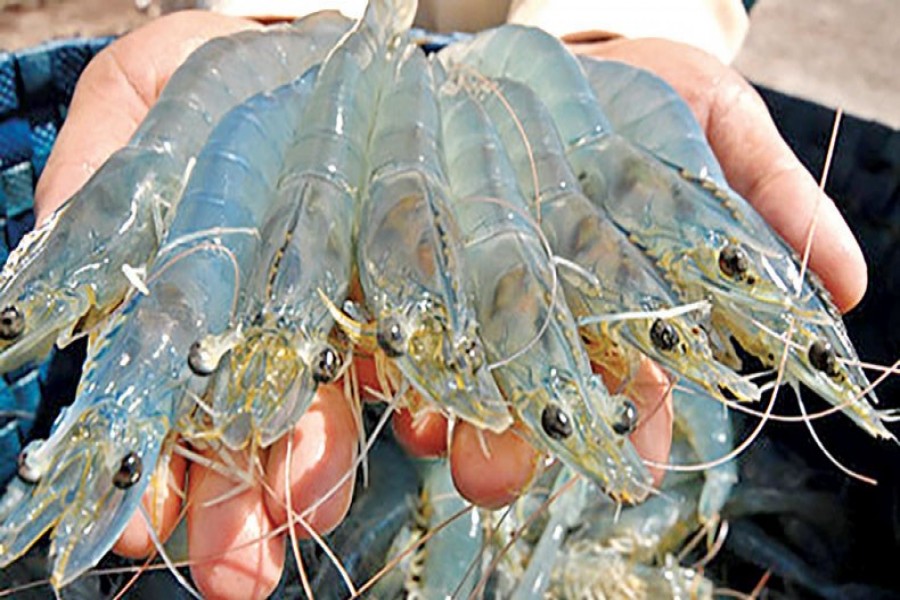Commercial farming of Vannamei shrimp to start by Mar
Decision will help double export of frozen shrimp in 5 yrs

Published :
Updated :

Bangladesh is set to start commercial production of vannamei shrimp by March this year with a view to adding to the country's export basket.
A technical committee, which was formed to examine the feasibility of vannamei shrimp farming in Bangladesh, has recently recommended that the country should go for commercial cultivation of the white-leg shrimp.
KH Mahbubul Haque, director general (DG) of the Department of Fisheries (DoF), told the FE that the technical committee has made the recommendation based on the report of a pilot project.
"We would send the report to the Ministry of Fisheries and Livestock this week for approval - hopefully, we would get consent from the higher authority this month," he said.
If the report gets approval, production would start by March, said Mr Haque, also head of the technical committee.
Earlier, in 2020, the DoF for the first time permitted two pilot projects on vannamei shrimp farming.
One project was run by Shushilan at the Saline Water Centre of the Bangladesh Fisheries Research Institute (BFRI) in the coastal Paikgachha upazila of Khulna. It launched cultivation in March 2021 and harvested its first batch of 13,896 kilograms of shrimp in July 2021.
However, the other one by the Agribusiness Enterprise Development and Services did not start operations.
Following the success of the first pilot project, the DoF permitted 11 more firms, including M.U. Sea Foods Ltd, Grow tech Aquaculture ltd, and Fahim Seafood Ltd, at different times to cultivate the hybrid shrimp variety on a trial basis.
Frozen fish exporters have long been demanding that the government allow vannamei farming, as Bangladesh's black-tiger shrimp species has lost price competitiveness in key western markets, like the United States (US) and the European Union (EU).
Asked, DoF chief Mahbubul Haque said the applicants, who can fulfil the criteria according to the existing guidelines, will be allowed to go for vannamei cultivation.
At the same time, Mr Haque said they will also permit establishing hatcheries for production of vannamei fry.
"We will allow vannamei cultivation under certain conditions, including maintaining biosecurity, quality, etc.," he added.
The DoF chief also said they would not permit farming outside the coastal zone.
Md Amin Ullah, president of Bangladesh Frozen Foods Exporters' Association, said the decision to go for vannamei farming is a great piece of news for the sector, as they have been demanding it for long.
The export volume and earnings from the frozen shrimp sector will simply double within five years because of the decision, he observed, adding that it will also help meet the local demand for shrimp.
There will be a capacity utilisation of the frozen fish processing units, and the sick ones will get a chance to turn around through farming the vannamei shrimp variety, Mr Ullah hoped.
According to the frozen fish exporters, vannamei is a leading item on the global shrimp market because of its affordable price.
More than 60 countries, including China, India, Vietnam, Thailand, Indonesia, Malaysia, Ecuador and Mexico, are producing vannamei, meeting about 80 per cent of total shrimp demand in the globe.
However, Bangladesh exports only 2.0 per cent of the international demand for frozen shrimp, as per the Bangladesh Shrimp and Fish Foundation.
The country earned from shrimp export US$361 million in fiscal year (FY) 2018-19, $332 million in FY 2019-20, $320 million in FY 2020-21, and $407.25 million in FY 2021-22, as per the data available with the Export Promotion Bureau.
The earnings, however, declined by 31.87 per cent in the first six months of the current fiscal. Exporters earned $183.23 million in the July-December period of FY 2022-23, down from $268.95 million in the corresponding period of FY2021-22.
The country once boasted about 100 frozen-fish factories, occupying the second position among the total export-oriented sectors even a decade ago.
But the number has come down to as low as 30 to 35 at present, mainly because of the exportable shrimp crisis.
arafataradhaka@gmail.com


 For all latest news, follow The Financial Express Google News channel.
For all latest news, follow The Financial Express Google News channel.